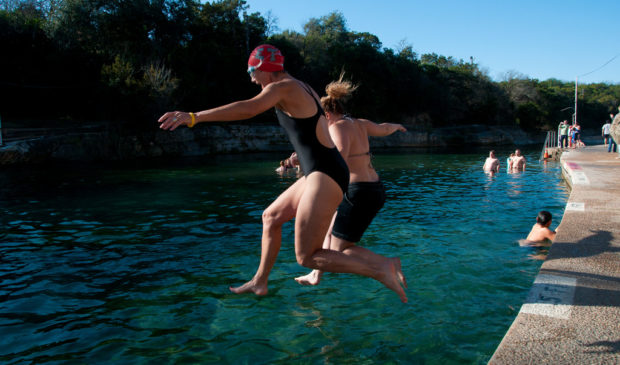Aquatics task force says in all scenarios, Austin pools need more money
Monday, November 20, 2017 by
Jessi Devenyns After several months of scrutiny by both the public and the City Council-appointed Aquatic Master Plan Task Force, the 150-page Aquatic Master Plan is getting the final touches to be presented to Council in December.
The redesign of Austin’s aquatics system is a monumental undertaking that in every proposed permutation seems to require a lot more money than anticipated. In early August, despite months of work on the master plan, Council voted to postpone approval of the plan in favor of forming a task force to further verify the impending revitalization expenditures with the public.
On Nov. 14, this task force convened for the penultimate time with the aim of formulating recommendations to amend the Aquatic Master Plan’s draft language.
The task force, which is composed of Parks and Recreation Board members, found itself once again in a circular discussion regarding how to bring in more money to limit planned pool decommissions without raising taxes.
Task force member Jane Rivera said, “A good part of what we need to convey in our recommendation is that pools need more budget.” She explained that the current predicament is a “catch-up situation,” and if the city doesn’t dig deep into its coffers, it will soon be prohibitively expensive to provide public pools for an expanding populace.
The financial situation is so strained that task force member Richard DePalma said, “We can remove four pools right now, and we still have a funding problem.”
Without approving a larger budget, PARD Aquatic Division Program Manager Jodi Jay said, the pools are at risk of becoming non-operational and shutting themselves down.
To avoid this scenario, Rivera suggested issuing bonds that explicitly outline the intended use of dollars. She said that setting an expectation that pools will be revitalized in priority order would encourage citizens to more willingly approve multiple bonds in hopes that their pool will be the next recipient on the list.
Rick Cofer, the task force chair, noted that when he spoke to public stakeholders, “There has been some inclination to have a more robust bond for aquatics in 2018.”
This suggestion stands in stark contrast to the current approach of prioritized decommissioning presented in the master plan. Cofer reiterated that the decommissioning plan would not take immediate effect. A pool would only be shuttered when it is in need of significant investment and the expense to repair it is too great to justify based on the patronage that the pool attracts.
Although the consensus seemed to be that more money needed to be funneled toward aquatics, task force member Dawn Lewis said, “I still feel that there are some ways for us to dig in here and cut expenses in the master plan.”
Rivera suggested that the city reduce utility rates for the pools. She explained that since city pools operate to benefit the public and the money they pay to keep them running is simply returned to the city, it would be mutually beneficial to discount utility rates.
She did note that because “it’s part of our responsibility to suggest some ideas for where we can get money besides city coffers,” the city should take advantage of the public’s willingness to contribute to aquatics.
Task force members agreed that with a $90 million price tag attached to the aquatics system revitalization effort, it was only natural for the public to have input as to its contributions. “I hear a mix as to whether or not those pools should remain free,” said Cofer.
Lewis echoed his statement, saying that during open public meetings about the pools, the public expressed a general willingness to pay an entrance fee. “They felt like they had ownership of the pools and were more likely to take care of them,” she said. Rivera agreed that she had heard the same thing and that personally, “I’d be willing to pay more taxes for more pools.”
Overall, the most frequent request that the task force members have heard is not to close neighborhood pools.
The Aquatic Task Force will take all input and come up with recommendations to amend the current master plan by its Nov. 29 meeting. The plan will be presented at the Dec. 5 Parks and Recreation Board meeting and then proceed to Council before the end of the year.
Photo by Randall Chancellor made available through a Creative Commons license.
The Austin Monitor’s work is made possible by donations from the community. Though our reporting covers donors from time to time, we are careful to keep business and editorial efforts separate while maintaining transparency. A complete list of donors is available here, and our code of ethics is explained here.
You're a community leader
And we’re honored you look to us for serious, in-depth news. You know a strong community needs local and dedicated watchdog reporting. We’re here for you and that won’t change. Now will you take the powerful next step and support our nonprofit news organization?



